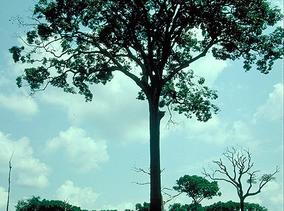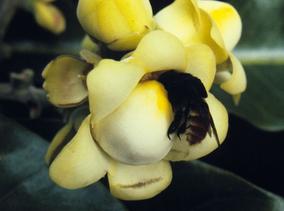You are here
List of Names
Lecythidaceae
Bertholletia excelsa Bonpl.
Nomenclature
-
Genus: Bertholletia
-
Synonyms: 1
SUMMARY
Trees, to 50 m tall, the trunk not buttressed. Bark fissured, the outer bark thick, the inner bark thick, reddish. Twigs 5-10 mm diam., those with fruits thickest, glabrous at maturity. Leaves scattered at ends of branches; petioles 20-35 mm long, very narrowly alate, caniculate adaxially, rounded abaxially; blades oblong, 17-36 x 6.5-15.4 cm, glabrous, discolorous, adaxially, papillate abaxially (best seen with SEM), the base rounded, the margins entire to slightly crenulate, undulate, the apex apiculate; venation brochidodromous, the midrib slightly impressed basally, prominulous apically, salient abaxially, the secondary veins in 25-45 pairs, plane to prominulous adaxially, prominulous abaxially, intersecondaries present, reaching one-half distance between midrib and margin, the tertiary veins reticulate. Inflorescences terminal or axillary, spicate or paniculate arrangements of spikes with 1-2 orders of branching, the rachis 12-19 cm long, ca. 5 mm thick at anthesis, 12-19 mm thick when bearing fruits; pedicel/hypanthium 2-3 mm long below articulation, absent above articulation, the bract caducous, shape, length, and width not recorded, bracteoles caducous, shape, length, and width not recorded. Flowers when leaves present, ca. 3 cm diam.; hypanthium truncate, puberulous, green, longitudinally oriented mucilage-bearing ducts absent; calyx-lobes 2(3) fused, apical slit present, valvate, obliquely oriented upward, ca. 10 x 10 mm, green, the margins entire; petals 6, shape and size not recorded, glabrous at anthesis, pale yellow to white; androecium zygomorphic, a staminal lip present, the staminal ring with numerous stamens, the filament length not recorded, clavate, white, the anther length not recorded, yellow, the appendage free ligule sometimes pinkish to purple on both surfaces (only visible in fresh flowers), the hood curved, outer surface smooth, white proximally, yellow distally (i.e., at entrance into flower), with numerous vestigial stamens, yellow, not stalked, proximal vestigial stamens swept inward, staminodes absent, posterior and anterior hood extensions present; ovary (3)4(6)-locular, the ovary summit truncate, the ovules ca. 4 per locule, inserted on basal septum, oblique, the style tapering to apex, oblique or geniculate, ca. 10 mm long, stylar collar absent. Fruits dehiscent, the opening smaller than seeds, falling to ground with seeds inside at maturity, usually globose, 10-12.5 (16) cm diam., the calyx-lobes not persistent, the calyx-lobe scars not visible, the infracalycine zone not separated from the supraclaycine zone, rounded to pedicel, the pericarp ca. 20 mm thick, smooth to slightly rough, brown, the operculum, 1.5–2 cm diam., falling inside fruit at dehiscence, the columella ca. 2 cm long, the opercular opening smaller in diameter than seeds. Seeds 3-angled, 10-25 per fruit, 4–5 x 2–2.5 cm, the testa 2–3 mm, thick, boney, dark brown, the primary veins running longitudinally along angles, the secondary veins horizontally oriented between primary veins; aril absent; endosperm not evident in seeds; embryo without cotyledons (macropodial).





